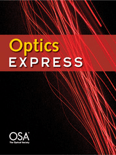
OPTICS EXPRESS
Scope & Guideline
Empowering the Global Optics Community
Introduction
Aims and Scopes
- Biomedical Imaging Technologies:
The journal focuses on the development and application of optical techniques for biomedical imaging, including optical coherence tomography (OCT), multiphoton microscopy, and photoacoustic imaging. These technologies are crucial for non-invasive diagnostics and monitoring of various medical conditions. - Optical Sensors and Sensing Techniques:
Research on novel optical sensors, including fiber optic biosensors and spectroscopic methods, is a significant area of focus. These sensors are essential for detecting biological markers, environmental monitoring, and enhancing diagnostic capabilities. - Adaptive Optics and Wavefront Control:
The application of adaptive optics to improve imaging quality in complex media, such as the human eye, is a prominent theme. This includes techniques for correcting aberrations in real-time to enhance the resolution of optical imaging systems. - Machine Learning and Computational Imaging:
The integration of machine learning techniques for image analysis, segmentation, and reconstruction in optical imaging is increasingly represented. This includes the use of deep learning for enhancing image quality and automating diagnostic processes. - Light-Matter Interaction and Novel Materials:
Research exploring the interaction of light with novel materials, including metamaterials and nanostructures, is an essential aspect. This encompasses studies on photonic devices, plasmonics, and their applications in sensing and imaging.
Trending and Emerging
- Integration of Artificial Intelligence in Imaging:
The application of AI and machine learning in optical imaging and analysis is on the rise. This includes using neural networks for image enhancement, segmentation, and real-time data processing, reflecting a broader trend towards computational imaging. - Novel Therapeutic Applications of Optical Techniques:
Research focusing on the therapeutic use of optical methods, such as photodynamic therapy and laser treatments for various medical conditions, is gaining traction. This trend highlights the clinical relevance of optical technologies in treating diseases. - Wearable and Portable Optical Devices:
There is an increased interest in developing portable and wearable optical devices for health monitoring and diagnostics. This includes smartphone-integrated imaging systems and non-invasive sensors that enable real-time health assessments. - Multimodal Imaging Approaches:
The trend towards multimodal imaging techniques is evident, where researchers combine different imaging modalities (e.g., OCT with fluorescence or photoacoustic imaging) to provide comprehensive insights into biological systems. - Optical Techniques in Environmental Monitoring:
The application of optical methods for environmental monitoring and assessment is emerging as a significant focus. This includes using spectroscopy and imaging techniques to study pollutants and biological interactions in ecosystems.
Declining or Waning
- Traditional Optical Imaging Techniques:
There is a noticeable decrease in publications focused on traditional optical imaging methods, such as standard fluorescence microscopy, as researchers increasingly turn to more advanced techniques like super-resolution and multimodal imaging. - Basic Theoretical Studies in Optics:
Papers that primarily focus on theoretical explorations without significant experimental validation or application are becoming less frequent. The journal is increasingly prioritizing studies that demonstrate practical applications or technological advancements. - Static Imaging Systems:
Research on static imaging systems, which do not incorporate adaptive or dynamic elements, is waning. The trend is moving towards systems that employ adaptive optics or real-time adjustments to enhance imaging capabilities.
Similar Journals

Opto-Electronic Advances
Advancing the Frontiers of Opto-ElectronicsOpto-Electronic Advances is a premier open-access journal published by the Chinese Academy of Sciences' Institute of Optics & Electronics, dedicated to advancing the fields of optics and electronic engineering. Established in 2018, this journal quickly ascended to a Q1 ranking across multiple categories including Atomic and Molecular Physics, Electrical and Electronic Engineering, and Electronic, Optical and Magnetic Materials, showcasing its impact and relevance in the scientific community. With an impressive Scopus ranking placing it in the top percentiles for critical fields such as Engineering, Materials Science, and Physics, Opto-Electronic Advances provides a platform for researchers to publish their cutting-edge findings and foster dialogue in an increasingly interdisciplinary area of study. The journal emphasizes innovative research that contributes to practical applications and theoretical frameworks in its domain, making it an invaluable resource for academicians, industry practitioners, and students alike. Embrace the future of opto-electronic research with Opto-Electronic Advances, which has been fully open access since 2021, ensuring that knowledge is widely disseminated without barriers.

eLight
Advancing Knowledge at the Intersection of Physics and Materials ScienceeLight is a leading academic journal published by SPRINGER NATURE, dedicated to the dynamic field of Atomic and Molecular Physics, as well as Electronic, Optical, and Magnetic Materials. Launched in 2021, the journal has quickly established itself as a reputable source of cutting-edge research, evidenced by its impressive Q1 quartile rankings in both categories for 2023, alongside remarkable Scopus rankings that place it in the top 2% of its fields. With a commitment to advancing knowledge and fostering innovation, eLight invites contributions from researchers, professionals, and students who are passionate about exploring new frontiers in these critical areas of study. Hitting a critical intersection of physics and materials science, the journal provides an open forum for the dissemination of experimental findings, theoretical studies, and application-based research, ensuring accessibility to vital discoveries that drive progress in technology and academia. Located in Singapore, eLight is poised to make significant contributions to the scientific community until at least 2024, and beyond.

Acta Photonica Sinica
Exploring the Depths of Optical InnovationActa Photonica Sinica is a peer-reviewed academic journal published by SCIENCE PRESS, focusing on the fields of atomic and molecular physics and optics. Since its inception in 1997, this journal has provided a crucial platform for researchers and professionals to share cutting-edge findings and advancements in photonics and related areas. Despite its current positioning in the Q4 quartile for both atomic and molecular physics and optics, Acta Photonica Sinica remains a significant contributor to the scholarly community, fostering innovative discussions and collaborations. The journal does not currently offer open access, providing a selective but impactful repository of knowledge for readers in China and beyond. As the scientific landscape evolves, the journal aims to enhance its scope and impact, addressing the challenges and opportunities within the photonics domain. Researchers, students, and professionals interested in the latest theoretical and experimental studies will find a wealth of information that emphasizes the pivotal role of optics in scientific and technological advancements.
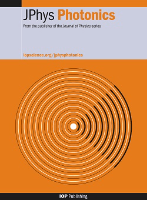
Journal of Physics-Photonics
Fostering Collaboration in the World of PhotonicsJournal of Physics-Photonics, published by IOP Publishing Ltd in the United Kingdom, is an esteemed Open Access journal that has been at the forefront of research in the field of photonics since its inception in 2018. With an impressive portfolio, the journal has achieved Q1 ranking in 2023 across multiple disciplines, including Atomic and Molecular Physics, Electrical and Electronic Engineering, and Electronic, Optical, and Magnetic Materials. This positions it among the leading journals in these areas, reflecting its significant influence and contribution to advancing knowledge and innovation. The journal aims to disseminate high-quality research findings that encompass a wide range of topics in photonics, promoting interdisciplinary approach that fosters collaboration among researchers, professionals, and students. With its commitment to open access, Journal of Physics-Photonics ensures that groundbreaking research is accessible to all, empowering a global audience to engage with and benefit from the latest advancements in photonic technologies.
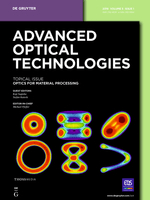
Advanced Optical Technologies
Advancing Knowledge in Optics and PhotonicsAdvanced Optical Technologies is a reputable journal dedicated to advancing the field of optics and photonics, published by FRONTIERS MEDIA SA in Switzerland. Since its inception in 2012, the journal has made significant contributions to the domains of Atomic and Molecular Physics, Electronic, Optical and Magnetic Materials, and Instrumentation, achieving commendable rankings within these categories, including a Q2 quartile classification in 2023. With an emphasis on open access, Advanced Optical Technologies aims to facilitate the rapid dissemination of research findings, thereby fostering collaboration and innovation among researchers, professionals, and students alike. The journal serves as an essential platform for cutting-edge research articles, reviews, and technical notes, and its commitment to quality is reflected in its robust Scopus rankings. As the field of optical technologies continues to expand, this journal plays a crucial role in highlighting pivotal advancements and promoting interdisciplinary dialogue among scholars in the scientific community.

Photonics, an esteemed journal published by MDPI, is a leading platform for researchers in the fields of atomic and molecular physics, optics, and instrumentation. Since its inception in 2014, the journal has fostered open access to cutting-edge research, facilitating knowledge dissemination in these dynamic disciplines. With its Q2 ranking in the 2023 Scopus metrics for various categories, including radiology, nuclear medicine, and imaging, Photonics represents a crucial academic resource for professionals and students seeking to advance their understanding and expertise. Located in Basel, Switzerland, the journal plays a pivotal role in bridging theoretical and practical approaches to photonic technologies. Researchers are encouraged to contribute their findings, thereby enriching the journal’s impact and relevance in the global scientific community through collaboration and innovation.
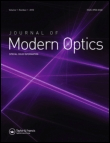
JOURNAL OF MODERN OPTICS
Illuminating the Future of Optical ScienceJOURNAL OF MODERN OPTICS, published by Taylor & Francis Ltd, stands as a prominent bi-monthly journal contributing to the fields of Atomic and Molecular Physics and Optics. With an ISSN of 0950-0340 and an E-ISSN of 1362-3044, this journal aims to disseminate high-quality research that pushes the boundaries of optical science and its applications. Since its inception in 1981, and particularly throughout its publications from 1987 to 2024, the journal has consistently published influential studies that are essential for both academic researchers and industry professionals. Ranked in the Q3 quartile for the 2023 category of Atomic and Molecular Physics and Optics, it has a Scopus ranking of #133 out of 224, indicating its steady presence and relevance in the scientific community. Although it does not offer Open Access options, readers can access its rich repository of literature that delves into innovative optical methods, technological advancements, and theoretical frameworks. The JOURNAL OF MODERN OPTICS is an indispensable resource for those seeking to advance their knowledge and research in modern optical science.

Computer Optics
Exploring Innovative Frontiers in Optical ComputingComputer Optics is a prominent academic journal dedicated to advancing the field of optics and its integration with computer science, published by the IMAGE PROCESSING SYSTEMS INST of the Russian Academy of Sciences. With an ISSN of 0134-2452 and an E-ISSN of 2412-6179, this journal has been a vital resource for researchers and professionals since it became Open Access in 1987, promoting the free dissemination of knowledge. Based in Samara, Russia, Computer Optics covers a broad range of relevant topics, with its scope spanning atomic and molecular physics, optics, computer vision, and electrical engineering. Although characterized within Q4 and Q3 quartiles in various categories in 2023, its rigorous peer-review process ensures the publication of high-quality research contributions. The journal is crucial for those wishing to explore interdisciplinary approaches that merge practical applications of optics with cutting-edge computer technologies, thereby acting as a bridge between these dynamic fields.

Current Optics and Photonics
Empowering Researchers in Optics and PhotonicsCurrent Optics and Photonics is a premier journal published by the Optical Society Korea, focusing on the dynamic and evolving fields of optics and photonics. With an ISSN of 2508-7266 and E-ISSN 2508-7274, it provides a comprehensive platform for scholarly communication, emphasizing innovations, advances in technology, and theoretical developments in atomic and molecular physics and optics. Situated in South Korea's vibrant academic landscape, this open access journal aims to bridge the gap between theoretical research and practical applications, fostering collaboration and knowledge sharing among researchers, professionals, and students alike. Although currently ranked in the Q3 category for both Atomic and Molecular Physics and Optics, with a Scopus rank of #183/224, it showcases significant contributions that enhance understanding in these critical areas. The journal encourages submission of original research articles, reviews, and technical notes, with the objective of driving forward the conversation in optics and photonics throughout its converged years from 2017 to 2024. Embrace the opportunity to contribute to this expanding field and become part of a community that is at the forefront of scientific discovery.
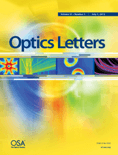
OPTICS LETTERS
Advancing Knowledge in Optics and PhotonicsOPTICS LETTERS is a premier academic journal published by the Optica Publishing Group, dedicated to advancing the field of optics and photonics. Since its inception in 1977, it has maintained a strong reputation for publishing high-impact research, holding a distinguished Q1 category ranking in Atomic and Molecular Physics, as well as Optics, making it a vital resource for researchers and professionals alike. With an impressive Scopus rank of #55 out of 224 in its field, OPTICS LETTERS continues to shape the discourse and innovation in optical science. Authors benefit from its extensive international reach, while readers gain access to cutting-edge studies that address both theoretical and applied aspects of optics. Although the journal currently does not offer open access options, its rigorous peer-review standards ensure that every publication meets the highest academic criteria, making it an essential journal for anyone looking to stay at the forefront of optical research.